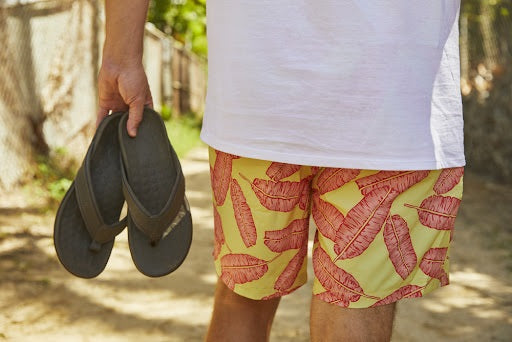Signs of Plantar Fasciitis


If you have a hard time taking a step without wincing or your heel feels like it’s on literal pins and needles as you walk, you may have plantar fasciitis.
Plantar fasciitis occurs when the plantar fascia tissue that runs along the bottom of your foot, connecting your heel bone to your toes, becomes inflamed. The health of this connective tissue is important for everyday activities like standing and walking, and even more so for athletic activities like running and jumping. Your plantar fascia goes through normal wear and tear over the years, but excess strain on it can cause small tears in the tissue that lead to plantar fasciitis. This is why it is so important to wear a pair of shoes for plantar fasciitis daily if you suffer from this condition.
As one of the most frequent sources of foot pain in both athletes and average people, it’s important to understand:
- How plantar fasciitis develops
- Which activities put you most at risk
- Natural risk factors
- How to avoid plantar fasciitis
- Signs of plantar fasciitis
- How to treat plantar fasciitis
You don’t need a medical degree to stay informed about foot health and plantar fasciitis. This quick guide breaks down everything you need to know about plantar fasciitis in simple terms.
Plantar Fasciitis: What It Is and How It Happens
Not all cases of plantar fasciitis are the same. For some, the pain associated with plantar fasciitis comes and goes throughout the day and is quite mild. For others, the pain may last longer and be very severe. Plantar fasciitis can reappear even after being treated—many people experience it more than once.
With that in mind, it’s good to know exactly how plantar fasciitis is caused so you can be more prepared to identify and treat it. Let’s take a closer look at the anatomy of your foot to better understand the risks of plantar fasciitis.
What You Should Know About Plantar Fasciitis
There is a complex web of structures that make up the human foot. One of these structures— the plantar fascia—is a thick band of tissue, like a ligament, in the bottom of your foot. There are many other ligaments, tendons, and muscle tissues in your foot.
You can think of the plantar fascia in particular as a shock absorber. Running along the bottom of your foot, this thick and fibrous tissue is essential for holding up the weight of your body every single time you stand or walk. It can be easy to forget, but we humans are very unusual when it comes to supporting our size and stature on only two legs.
Standing and walking may seem to be two of the most basic tasks people generally perform on an everyday basis. However, they require a massive amount of support from our bones and tissues. Consider this: the average American male weighs nearly 200 pounds and the average American female over 170 pounds.¹ Your two plantar fascia are responsible for carrying that weight and for absorbing that much pressure when you stand, walk, run, and jump.

How Plantar Fasciitis is Caused
Responsible for such a heavy burden every day, it’s normal for the plantar fascia to experience minor degradation over the course of a lifetime. With the tissue undergoing so much pressure for such a long time, small tears begin to develop.
Plantar fasciitis can develop even if you’re not especially active. Certain people are at a higher natural risk for plantar fasciitis than others. These include people who:
- Are between the ages of 40 and 70
- Are overweight or obese
- Have flat feet or high arches
- Have stiff ankles, tight calf muscles, or an injured Achilles tendon
- Are pregnant
In addition to these natural risk factors, there are many physical activities that increase your chances of developing plantar fasciitis. These include but are not limited to:
- Going barefoot on hard surfaces like streets, paved tracks, courts, etc.
- Walking, jogging, or running frequently
- Standing on your feet for most of the day, usually for work
- Playing high-impact sports that take place on hard surfaces like basketball, tennis, volleyball, etc.
How to Tell if You Have Plantar Fasciitis
Plantar fasciitis symptoms vary from person to person. If you look up “what are the symptoms of plantar fasciitis,” the search results may not always correspond to your experience. That doesn’t necessarily mean that you don’t have plantar fasciitis. When in doubt, you should always consult your doctor.
That being said, here are the 6 signs and symptoms of plantar fasciitis that are most common.
- Pain and tenderness – Most people with plantar fasciitis experience an ache in the foot that can range anywhere from mild tenderness to stabbing pain. This pain is often centralized around the heel, but it can extend all along the whole sole of the foot.
- Heel spurs – A heel spur is a small deposit of calcium that causes a bony protrusion on the side or bottom of the heel.² Although plantar fasciitis does not cause heel spurs, the same excess strain that leads to plantar fasciitis can also lead to heel spurs. That’s why so many people who experience plantar fasciitis also develop heel pain and spurs. If you notice a heel spur in your foot, you may be at risk of plantar fasciitis as well.
- Stiffness in the morning – People with plantar fasciitis frequently report experiencing “first-step pain.”³ That is, their feet feel very stiff and sensitive when they first get out of bed in the morning and take their first steps. Compression overnight can often help with this morning stiffness. Knowing when to wear compression socks for plantar fasciitis is key.
- Sitting ache – Another plantar fasciitis symptom is experiencing an ache after sitting down for a while. Some people mistakenly believe that they don’t have plantar fasciitis because they are able to perform vigorous physical exercise without foot pain. In fact, you’re more likely to feel plantar fasciitis pain after physical activity, not during it.
- Other sensations on the bottom of your foot – The inflammation in your plantar fascia may not be severe enough to cause tears (as in the tiny rips in your plantar fascia or tears of pain). In other words, you may be in the early stages of plantar fasciitis development. If so, instead of experiencing sharp pain, the bottom of your foot may feel warm or swollen.
- Knee, hip, and back problems – Although plantar fasciitis itself is limited to the foot, it can lead to pain or even injuries in other areas by changing the way you walk. A normal gait and good posture are crucial for maintaining strong support in your knees, hips, and back. If you have plantar fasciitis, you may change your gait or posture to relieve pressure and reduce pain. Unfortunately, those quick fixes can lead to long-term issues. Many people don’t know that plantar fasciitis and chiropractic help go hand in hand. Consider visiting a chiropractor for a holistic approach to solving your plantar fascia problems!
How to Know if You Have Plantar Fasciitis or a Plantar Fascia Rupture
It’s important to keep in mind that plantar fasciitis is not the same as a plantar fascia rupture. Small tears in the plantar fascia are not equivalent to ripping the whole tissue.
Whereas plantar fasciitis develops slowly over a long period of time and typically begins with a dull ache, a plantar fascia rupture:
- Happens in an instant (though it can be triggered by chronic overuse)
- Is often associated with feeling or hearing a “pop” when the injury occurs
- Often requires an X-Ray or MRI to diagnose
- Causes extreme pain
- Must be treated immediately
- Leads to severe bruising around the painful area
How to Treat Plantar Fasciitis
You don’t have to live with plantar fasciitis forever. Doctors can typically diagnose your plantar fasciitis simply by feeling around the sensitive area. Options like surgery or a steroid injection like cortisone shots are very rarely required. In all but the most severe cases, there are many nonsurgical treatments for plantar fasciitis. Some of these include:
- Performing lower impact exercises, like swimming and cycling
- Not going barefoot on hard surfaces
- Losing weight to lessen the load on your plantar fascia
- Stretching daily to increase the elasticity of your plantar fascia
Hopefully, after incorporating these tips into your routine, you will start to experience signs that your plantar fasciitis is healing.
Wondering how to prevent plantar fasciitis? All of these actions above can also help prevent plantar fasciitis or reduce your symptoms. However, the very best thing you can do to treat and prevent plantar fasciitis is to wear a supportive shoe like Vionic.

The Best Way to Prevent Plantar Fasciitis: Wearing Vionic
Luckily, the days of ugly orthotic shoes are over. Vionic allows you to purchase sneakers, dress shoes, sandals, and more with top-tier foot support and premier style. With Vionic shoes, you’ll never have to sacrifice style for comfort again.
Vionic shoes are scientifically developed to give you stability, arch support, and cushioning. The Vionic Innovative Lab has developed a biomedical footbed that goes in the sole of every Vionic shoe. Our ingenuity is recognized by leading industry experts at the American Podiatric Medical Association. You don’t have to deal with plantar fasciitis alone: Vionic has got you covered. Go out on your next adventure with confidence. Shop for plantar fasciitis shoes today.
Sources:
Country Foot Care. Plantar Fascia Rupture.
https://countryfootcare.com/library/heel-pain/plantar-fascia-rupture-a-tear-in-the-sole/
Care Plus. Plantar Fascia Ruptures.
https://www.bellevuefootdoctor.com/blog/plantar-fascia-ruptures
MedicineNet. Plantar Fasciitis.
https://www.medicinenet.com/plantar_fasciitis/article.htm
FootCare MD. What is Plantar Fasciitis?
https://www.footcaremd.org/conditions-treatments/heel/plantar-fasciitis
WebMD. Do I have Plantar Fasciitis?
https://www.webmd.com/fitness-exercise/understanding-plantar-fasciitis-symptoms
WebMD. Heel Spurs and Plantar Fasciitis.
https://www.webmd.com/pain-management/heel-spurs-pain-causes-symptoms-treatments#1
Centers for Disease Control and Prevention. Body Measurements.
https://www.cdc.gov/nchs/fastats/body-measurements.htm
Patient. Heel and Foot Pain.
https://patient.info/foot-care/heel-and-foot-pain-plantar-fasciitis





